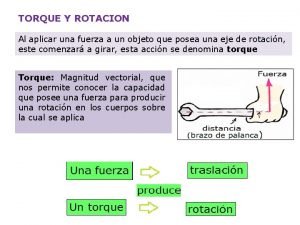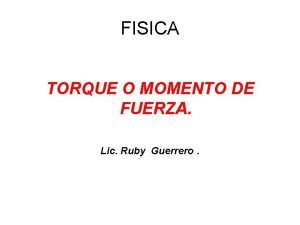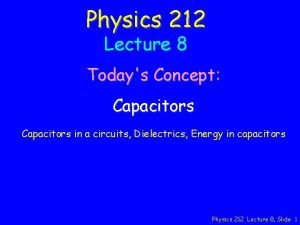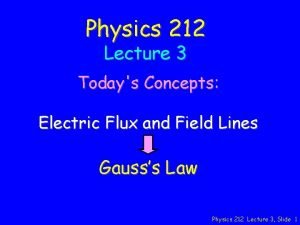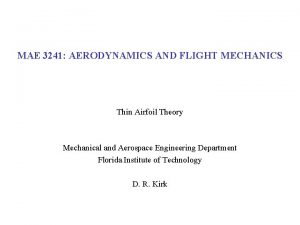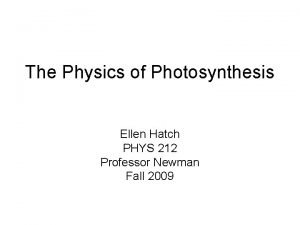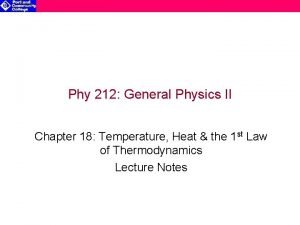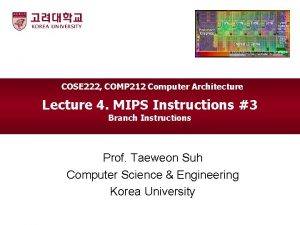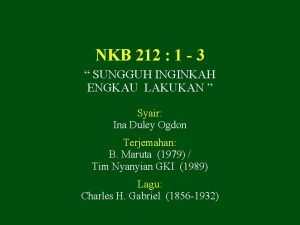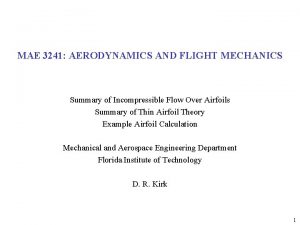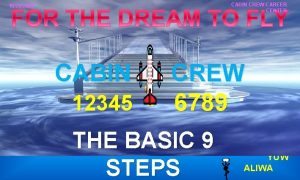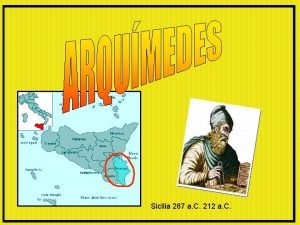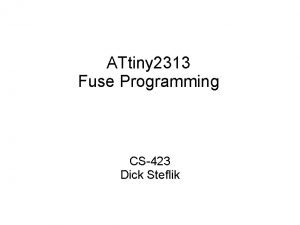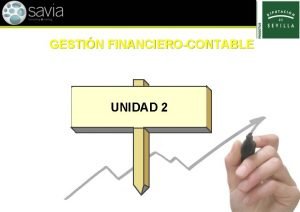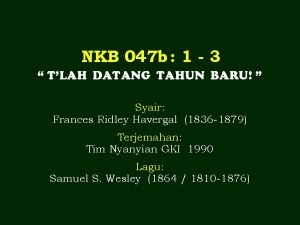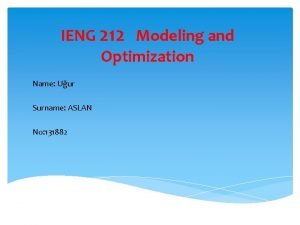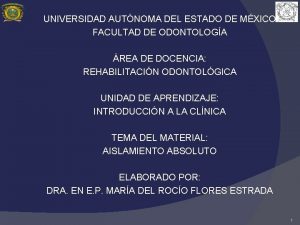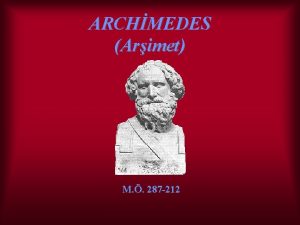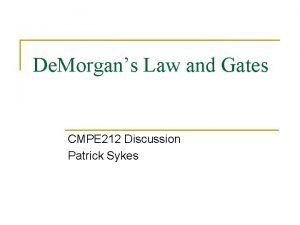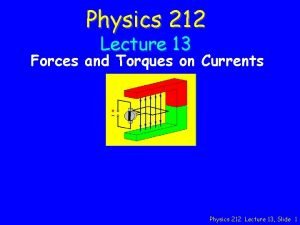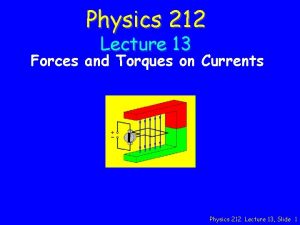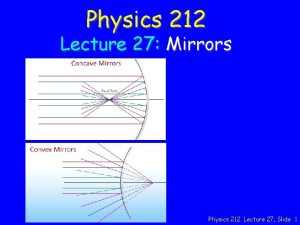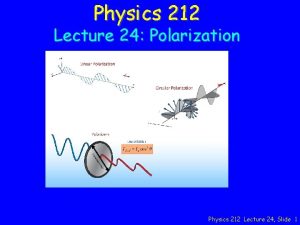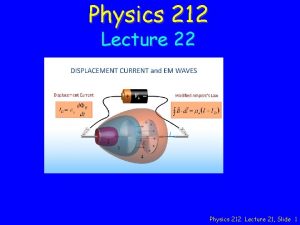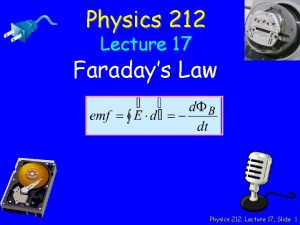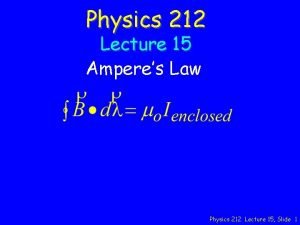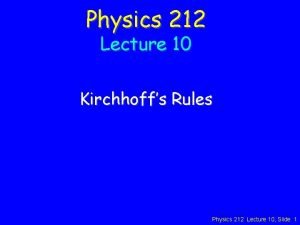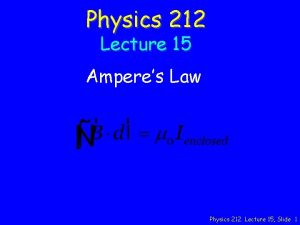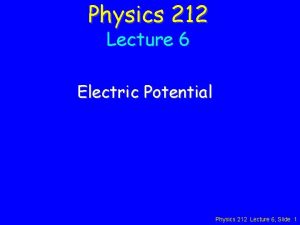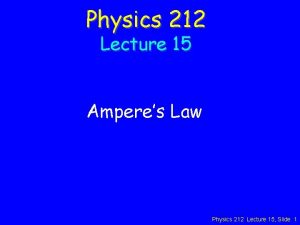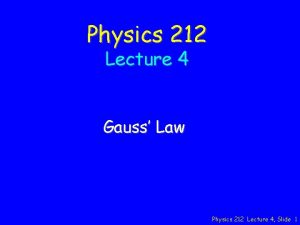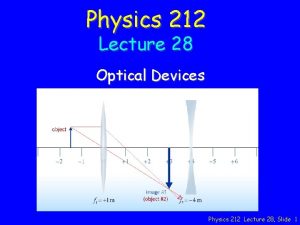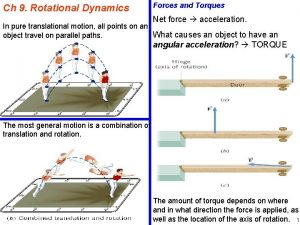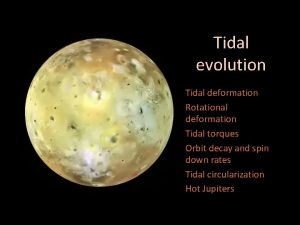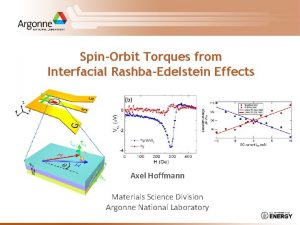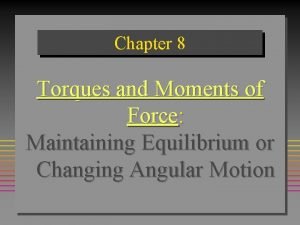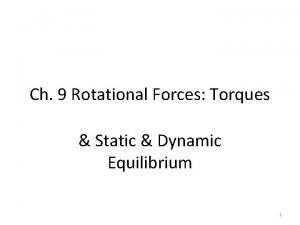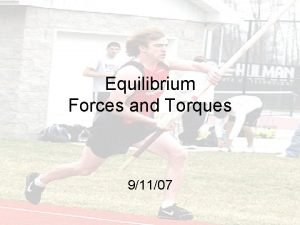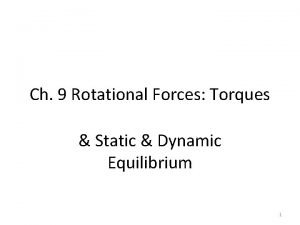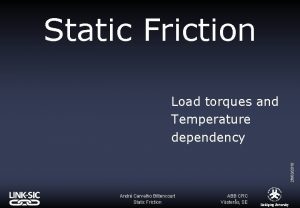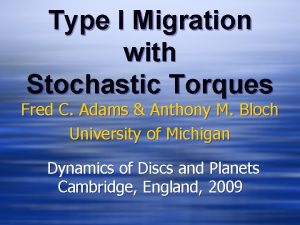Physics 212 Lecture 13 Torques Physics 212 Lecture
























- Slides: 24

Physics 212 Lecture 13 Torques Physics 212 Lecture 13, Slide 1

Main Point 1 First, we investigated the force on a straight section of a current carrying wire in a region containing a uniform magnetic field to determine that this force can be written as the current times the cross product of the length of the segment with the magnetic field. We then determined that if the wire were not straight, but rather curved, the same expression for the magnetic force holds, if we define the length vector to be the straight line that connects the ends of the segment. An important special case is the current loop, which since it begins and ends at the same point has a length vector of zero resulting in a zero net force on the loop. Physics 212 Lecture 13, Slide 2

Main Point 2 Second, we introduced an important new quantity m, the magnetic dipole moment of a current loop, which we used to quantitatively describe the interactions of the loop with a uniform magnetic field. m was defined to be a vector whose direction is perpendicular to the plane of the loop in a sense determined by yet another right hand rule, and whose magnitude was equal to the product of the current with the area of the loop. We determined that the torque exerted on the loop could be written simply as the cross product of m with the uniform magnetic field B. Physics 212 Lecture 13, Slide 3

Main Point 3 Finally, we defined the potential energy of a current loop in a uniform B field to be the negative of the work done by the magnetic field to change the orientation of m (mu) with respect to B. Choosing the zero of potential energy to be the position of maximum torque, we found we could write this potential energy U simply as minus the dot product of m with B. Physics 212 Lecture 13, Slide 4

Last Time: This Time: z y F B I x Physics 212 Lecture 13, Slide 5

ACT 08 Physics 212 Lecture 13, Slide 6

Physics 212 Lecture 13, Slide 7

Checkpoint 1 a A B C 13 Physics 212 Lecture 13, Slide 8

Checkpoint 1 b y x In which direction will the loop rotate? (assume the z axis is out of the page) A) B) C) D) 15 Around the x axis Around the y axis Around the z axis It will not rotate Physics 212 Lecture 13, Slide 9

Physics 212 Lecture 13, Slide 10

Checkpoint 1 c y A B C D E 17 Physics 212 Lecture 13, Slide 11

Checkpoint 2 a Three different orientations of a magnetic dipole moment in a constant magnetic field are shown below. Which orientation results in the largest magnetic torque on the dipole? 24 Physics 212 Lecture 13, Slide 12

Checkpoint 2 b Three different orientations of a magnetic dipole moment in a constant magnetic field are shown below. Which orientation has the most potential energy? 30 Physics 212 Lecture 13, Slide 13

Physics 212 Lecture 13, Slide 14

Checkpoint 2 c Three different orientations of a magnetic dipole moment in a constant magnetic field are shown below. In order to rotate a horizontal magnetic dipole to the three positions shown, which one requires the most work done by the magnetic field? fa qa qc B 30 Physics 212 Lecture 13, Slide 15

Physics 212 Lecture 13, Slide 16

Magnetic Dipole Moment Area vector Magnitude = Area Direction uses R. H. R. Magnetic Dipole moment Physics 212 Lecture 13, Slide 17

m makes torque easy! The torque always wants to line m up with B ! z turns m toward B m x B z y m x y B turns m toward B Physics 212 Lecture 13, Slide 18

Physics 212 Lecture 13, Slide 19

Magnetic Field can do Work on Current From Physics 211: From Physics 212: m B Physics 212 Lecture 13, Slide 20

Physics 212 Lecture 13, Slide 21

Calculation A square loop of side a lies in the x-z plane with current I as shown. The loop can rotate about x axis without friction. A uniform field B points along the +z axis. Assume a, I, and B are known. How much does the potential energy of the system change as the coil moves from its initial position to its final position. z z B . y a I x 30˚ initial B y final Conceptual Analysis Strategic Analysis Physics 212 Lecture 13, Slide 22

Physics 212 Lecture 13, Slide 23

Physics 212 Lecture 13, Slide 24
 Slidetodoc
Slidetodoc El torque
El torque Physics 212 gradebook
Physics 212 gradebook Physics 212 gradebook
Physics 212 gradebook 01:640:244 lecture notes - lecture 15: plat, idah, farad
01:640:244 lecture notes - lecture 15: plat, idah, farad Naca 2412 zero lift angle of attack
Naca 2412 zero lift angle of attack Phys 212 equation sheet
Phys 212 equation sheet Examples of convection
Examples of convection 212
212 Nkb 212
Nkb 212 Naca 2412
Naca 2412 Arm reach 212 cm on tiptoes
Arm reach 212 cm on tiptoes Et 212
Et 212 Garra de arquímedes
Garra de arquímedes Sfsu cls
Sfsu cls Attiny 212
Attiny 212 212 instalaciones tecnicas ejemplos
212 instalaciones tecnicas ejemplos Nkb no 47b
Nkb no 47b Cls 212
Cls 212 Ienf-212
Ienf-212 Tipos de dique de hule
Tipos de dique de hule Archimedes ( arşimet) (mö 287–212 )
Archimedes ( arşimet) (mö 287–212 ) Et 212
Et 212 Cmpe 212
Cmpe 212 X:3=212
X:3=212
